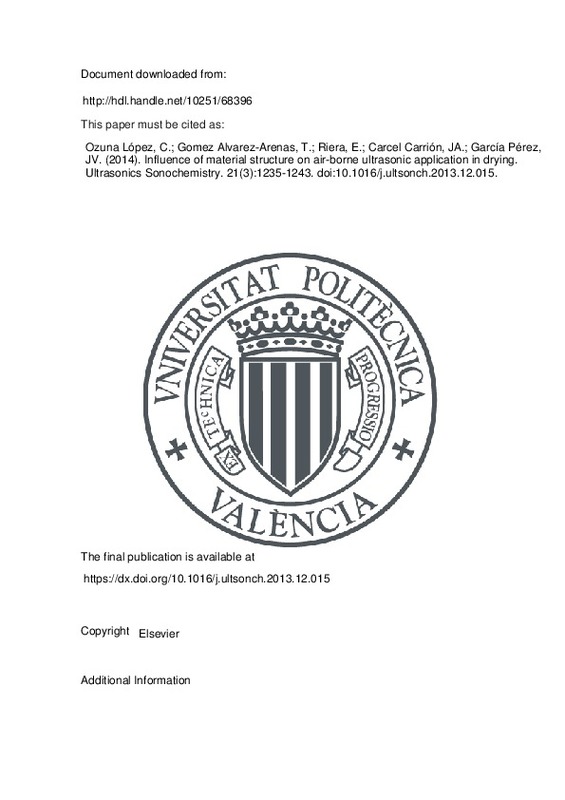JavaScript is disabled for your browser. Some features of this site may not work without it.
Buscar en RiuNet
Listar
Mi cuenta
Estadísticas
Ayuda RiuNet
Admin. UPV
Influence of material structure on air-borne ultrasonic application in drying
Mostrar el registro sencillo del ítem
Ficheros en el ítem
| dc.contributor.author | Ozuna López, César
|
es_ES |
| dc.contributor.author | Gomez Alvarez-Arenas, Tomas
|
es_ES |
| dc.contributor.author | Riera, Enrique
|
es_ES |
| dc.contributor.author | Cárcel Carrión, Juan Andrés
|
es_ES |
| dc.contributor.author | García Pérez, José Vicente
|
es_ES |
| dc.date.accessioned | 2016-07-28T12:13:57Z | |
| dc.date.available | 2016-07-28T12:13:57Z | |
| dc.date.issued | 2014-05 | |
| dc.identifier.issn | 1350-4177 | |
| dc.identifier.uri | http://hdl.handle.net/10251/68396 | |
| dc.description.abstract | [EN] This work aims to contribute to the understanding of how the properties of the material being dried affect air-borne ultrasonic application. To this end, the experimental drying kinetics (40 C and 1 m/s) of cassava (Manihot esculenta) and apple (Malus domestica var. Granny Smith) were carried out applying different ultrasonic powers (0, 6, 12, 19, 25 and 31 kW/m3). Furthermore, the power ultrasound-assisted drying kinetics of different fruits and vegetables (potato, eggplant, carrot, orange and lemon peel) already reported in previous studies were also analyzed. The structural, textural and acoustic properties of all these products were assessed, and the drying kinetics modeled by means of the diffusion theory. A significant linear correlation (r > 0.95) was established between the identified effective diffusivity (DW) and the applied ultrasonic power for the different products. The slope of this relationship (SDUP) was used as an index of the effectiveness of the ultrasonic application; thus the higher the SDUP, the more effective the ultrasound application. SDUP was well correlated (rP0.95) with the porosity and hardness. In addition, SDUP was largely affected by the acoustic impedance of the material being dried, showing a similar pattern with the impedance than the transmission coefficient of the acoustic energy on the interface. Thus, soft and open-porous product structures exhibited a better transmission of acoustic energy and were more prone to the mechanical effects of ultrasound. However, materials with a hard and closed-compact structure were less affected by acoustic energy due to the fact that the significant impedance differences between the product and the air cause high energy losses on the interface | es_ES |
| dc.description.sponsorship | The authors acknowledge the financial support of the Spanish Ministerio de Economia y Competitividad (Ref. DPI2012-37466-C03-03, DPI2012-37466-C03-03 and DPI2011-22438) and the assistance with the microstructural analysis provided by Dra. Ana Puig from Departamento de Tecnologia de Alimentos of Universitat Politecnica de Valencia (UPV). The author Cesar Ozuna thanks UPV for an FPI Grant (Ref. 2009-02). | en_EN |
| dc.language | Inglés | es_ES |
| dc.publisher | Elsevier | es_ES |
| dc.relation.ispartof | Ultrasonics Sonochemistry | es_ES |
| dc.rights | Reserva de todos los derechos | es_ES |
| dc.subject | Mass transport | es_ES |
| dc.subject | Ultrasound | es_ES |
| dc.subject | Porosity | es_ES |
| dc.subject | Microstructure | es_ES |
| dc.subject | Texture | es_ES |
| dc.subject.classification | TECNOLOGIA DE ALIMENTOS | es_ES |
| dc.title | Influence of material structure on air-borne ultrasonic application in drying | es_ES |
| dc.type | Artículo | es_ES |
| dc.identifier.doi | 10.1016/j.ultsonch.2013.12.015 | |
| dc.relation.projectID | info:eu-repo/grantAgreement/MINECO//DPI2012-37466-C03-03/ES/APLICACION DE LOS ULTRASONIDOS DE POTENCIA EN LA INTENSIFICACION DE PROCESOS DE SECADO A BAJA TEMPERATURA. ANALISIS DEL PROCESO Y EFICACIA ENERGETICA/ | es_ES |
| dc.relation.projectID | info:eu-repo/grantAgreement/UPV//FPI-2009-S2/ES/ | es_ES |
| dc.relation.projectID | info:eu-repo/grantAgreement/MICINN//DPI2011-22438/ES/NUEVAS TECNICAS ULTRASONICAS PARA ESTIMACION NO-INVASIVA. APLICACIONES INNOVADORAS EN TEJIDOS, VEGETALES, MATERIALES MICRO%2FNANOESTRUCTURADOS Y ELEMENTOS ESTRATEGICOS./ | es_ES |
| dc.rights.accessRights | Abierto | es_ES |
| dc.contributor.affiliation | Universitat Politècnica de València. Departamento de Tecnología de Alimentos - Departament de Tecnologia d'Aliments | es_ES |
| dc.contributor.affiliation | Universitat Politècnica de València. Escuela Técnica Superior de Ingeniería Agronómica y del Medio Natural - Escola Tècnica Superior d'Enginyeria Agronòmica i del Medi Natural | es_ES |
| dc.description.bibliographicCitation | Ozuna López, C.; Gomez Alvarez-Arenas, T.; Riera, E.; Cárcel Carrión, JA.; García Pérez, JV. (2014). Influence of material structure on air-borne ultrasonic application in drying. Ultrasonics Sonochemistry. 21(3):1235-1243. https://doi.org/10.1016/j.ultsonch.2013.12.015 | es_ES |
| dc.description.accrualMethod | S | es_ES |
| dc.relation.publisherversion | https://dx.doi.org/10.1016/j.ultsonch.2013.12.015 | es_ES |
| dc.description.upvformatpinicio | 1235 | es_ES |
| dc.description.upvformatpfin | 1243 | es_ES |
| dc.type.version | info:eu-repo/semantics/publishedVersion | es_ES |
| dc.description.volume | 21 | es_ES |
| dc.description.issue | 3 | es_ES |
| dc.relation.senia | 278961 | es_ES |
| dc.identifier.eissn | 1873-2828 | |
| dc.contributor.funder | Ministerio de Ciencia e Innovación | es_ES |
| dc.contributor.funder | Ministerio de Economía y Competitividad | es_ES |
| dc.contributor.funder | Universitat Politècnica de València |







![[Cerrado]](/themes/UPV/images/candado.png)

